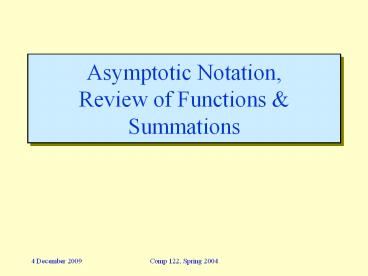Asymptotic Notation, Review of Functions PowerPoint PPT Presentation
1 / 14
Title: Asymptotic Notation, Review of Functions
1
Asymptotic Notation,Review of Functions
Summations
2
Asymptotic Complexity
- Running time of an algorithm as a function of
input size n for large n. - Expressed using only the highest-order term in
the expression for the exact running time. - Instead of exact running time, say Q(n2).
- Describes behavior of function in the limit.
- Written using Asymptotic Notation.
3
Asymptotic Notation
- Q, O, W, o, w
- Defined for functions over the natural numbers.
- Ex f(n) Q(n2).
- Describes how f(n) grows in comparison to n2.
- Define a set of functions in practice used to
compare two function sizes. - The notations describe different rate-of-growth
relations between the defining function and the
defined set of functions.
4
?-notation
For function g(n), we define ?(g(n)), big-Theta
of n, as the set
?(g(n)) f(n) ? positive constants c1, c2,
and n0, such that ?n ? n0, we have 0 ? c1g(n) ?
f(n) ? c2g(n)
Intuitively Set of all functions that have the
same rate of growth as g(n).
g(n) is an asymptotically tight bound for f(n).
5
?-notation
For function g(n), we define ?(g(n)), big-Theta
of n, as the set
?(g(n)) f(n) ? positive constants c1, c2,
and n0, such that ?n ? n0, we have 0 ? c1g(n) ?
f(n) ? c2g(n)
Technically, f(n) ? ?(g(n)). Older usage, f(n)
?(g(n)). Ill accept either
f(n) and g(n) are nonnegative, for large n.
6
Example
?(g(n)) f(n) ? positive constants c1, c2,
and n0, such that ?n ? n0, 0 ? c1g(n) ? f(n)
? c2g(n)
- 10n2 - 3n Q(n2)
- What constants for n0, c1, and c2 will work?
- Make c1 a little smaller than the leading
coefficient, and c2 a little bigger. - To compare orders of growth, look at the leading
term. - Exercise Prove that n2/2-3n Q(n2)
7
Example
?(g(n)) f(n) ? positive constants c1, c2,
and n0, such that ?n ? n0, 0 ? c1g(n) ? f(n)
? c2g(n)
- Is 3n3 ? Q(n4) ??
- How about 22n? Q(2n)??
8
O-notation
For function g(n), we define O(g(n)), big-O of n,
as the set
O(g(n)) f(n) ? positive constants c and n0,
such that ?n ? n0, we have 0 ? f(n) ? cg(n)
Intuitively Set of all functions whose rate of
growth is the same as or lower than that of g(n).
g(n) is an asymptotic upper bound for f(n).
f(n) ?(g(n)) ? f(n) O(g(n)). ?(g(n)) ?
O(g(n)).
9
Examples
O(g(n)) f(n) ? positive constants c and n0,
such that ?n ? n0, we have 0 ? f(n) ? cg(n)
- Any linear function an b is in O(n2). How?
- Show that 3n3O(n4) for appropriate c and n0.
10
? -notation
For function g(n), we define ?(g(n)), big-Omega
of n, as the set
?(g(n)) f(n) ? positive constants c and n0,
such that ?n ? n0, we have 0 ? cg(n) ? f(n)
Intuitively Set of all functions whose rate of
growth is the same as or higher than that of g(n).
g(n) is an asymptotic lower bound for f(n).
f(n) ?(g(n)) ? f(n) ?(g(n)). ?(g(n)) ?
?(g(n)).
11
Example
- ?n ?(lg n). Choose c and n0.
?(g(n)) f(n) ? positive constants c and n0,
such that ?n ? n0, we have 0 ? cg(n) ? f(n)
12
Relations Between Q, O, W
13
Relations Between Q, W, O
Theorem For any two functions g(n) and f(n),
f(n) ?(g(n)) iff f(n) O(g(n)) and
f(n) ?(g(n)).
- I.e., ?(g(n)) O(g(n)) Ç W(g(n))
- In practice, asymptotically tight bounds are
obtained from asymptotic upper and lower bounds.
14
Running Times
- Running time is O(f(n)) Þ Worst case is O(f(n))
- O(f(n)) bound on the worst-case running time ?
O(f(n)) bound on the running time of every input. - Q(f(n)) bound on the worst-case running time ?
Q(f(n)) bound on the running time of every input. - Running time is W(f(n)) Þ Best case is W(f(n))
- Can still say Worst-case running time is
W(f(n)) - Means worst-case running time is given by some
unspecified function g(n) Î W(f(n)).

